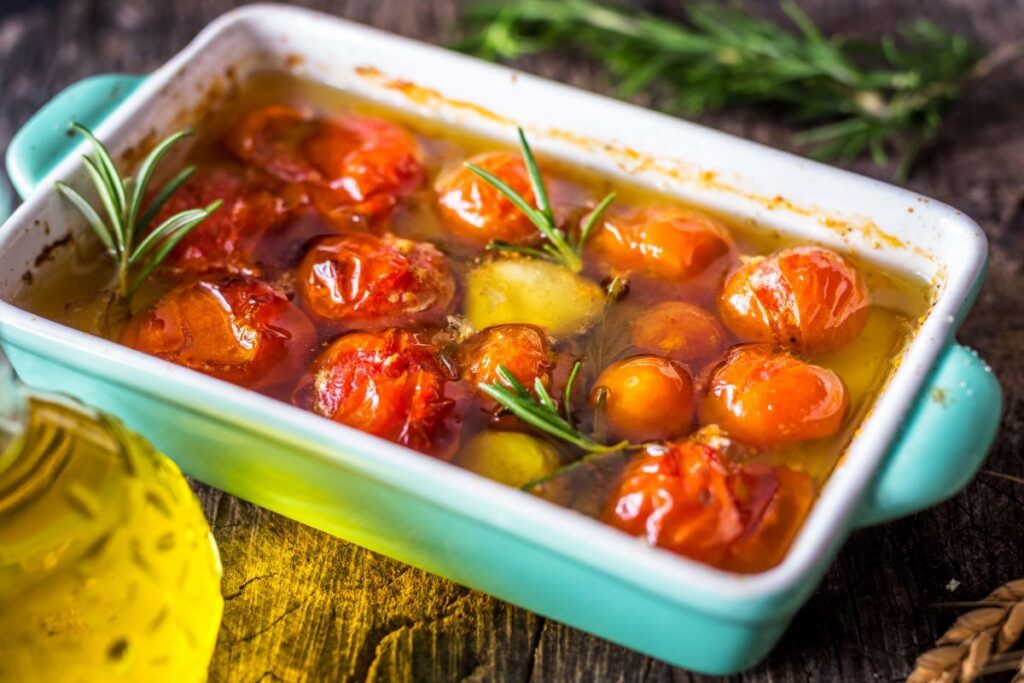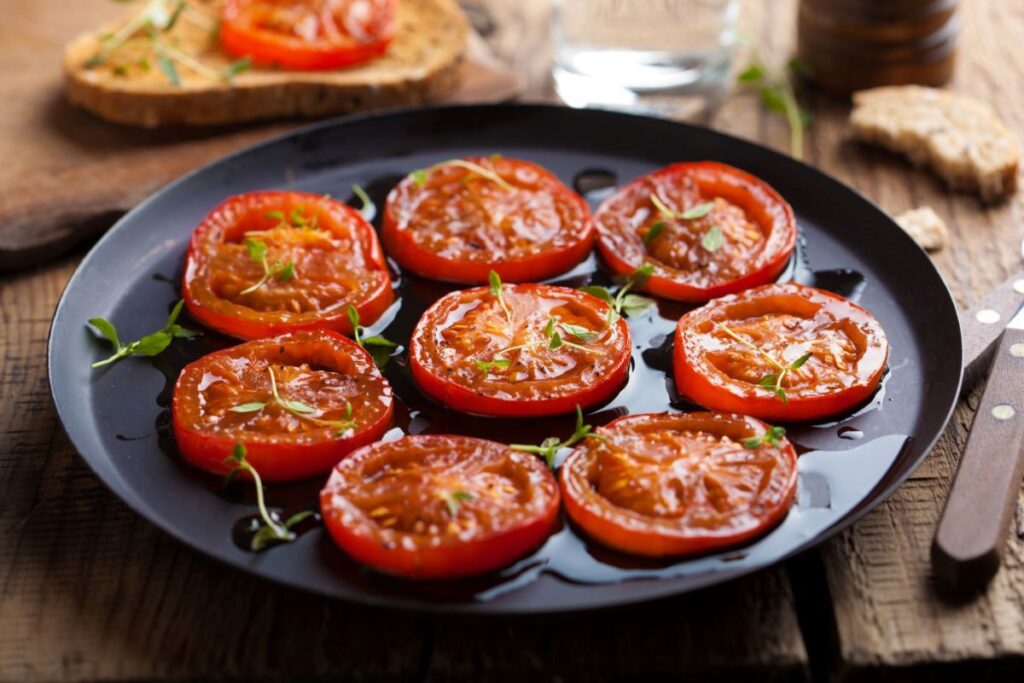Roasted tomatoes are a delectable treat! They add flavor to many dishes, and if you prepared loads of them at home, you might ask yourself how long you can keep them in olive oil to use later?
In the refrigerator, you can keep roasted tomatoes in olive oil for 1 to 3 weeks. The good news is that this time frame can exceed 6 months to 1 year in the freezer, but the roasted tomatoes should be fully submerged in the olive oil and placed in a tightly sealed container with little air inside.
In this article, I’ll explain:
- Exactly how long you can keep roasted tomatoes in olive oil
- The best practices that come along with it
- Some extra tips to save this concoction for extended periods
- A few ways to savor roasted tomatoes in olive oil to elevate your meals

How long do roasted tomatoes in olive oil last?
If you have roasted ripe tomatoes for a cozy get-together but end up with some leftovers, you might ponder how long you can preserve them in olive oil.
Well, roasted tomatoes in olive oil can last anywhere from 1 to 3 weeks in the refrigerator if you have stored them correctly.
Not bad, right?
Because then you’ve got plenty of time to enjoy them with your next meal.
Here comes the bonus: If you want to extend the shelf life of roasted tomatoes further, submerge them in olive oil entirely.
What you do is tightly seal the mix in a container with as little air as possible (to remove any oxygen). Then store it in your freezer. Voila!
This way, they will last for an impressive 6 months to a whole year. However, I should say that it’s best to consume them early for the best flavor and texture.
How do I preserve roasted tomatoes in olive oil?
Have you ever preserved your roasted tomatoes in olive oil, but they seem to just go a bit icky after not much time has passed?
You’re not alone!
There’s another way of doing this, and I’ll show you the method I use to store the mixture for a long time. Trust me; it’s easier than you might think.
Alright, first things first, take 2 ½ pounds of washed and ripe tomatoes.
Also, you’ll need some of your favorite herbs like:
- Rosemary
- Thyme
- Garlic
- Fresh oregano
- Basil leaves
Oh, and don’t forget sea salt as required and 2 cups olive oil.
Once you have gathered all the ingredients, remove the stem from the tomatoes. Cut them in half, and lay them in a deep ceramic or glass baking tray.
Sprinkle over some sea salt as required, add the herbs for extra flavor, and pour the olive oil over the tomatoes.
Preheat the oven to 175 F or 80 C, pop the baking tray inside, and slow-cook the mix for 3 to 5 hours until the tomatoes are blistered and shrunken.
Now let the mixture cool down, and transfer the dish into a glass jar or air-tight container. Finally, close the container and keep it in the fridge or freezer for preservation.

How To Keep Roasted Tomatoes In Olive Oil Longer?
You are in luck! I’ve got some extra tricks up my sleeves to keep those roasted tomatoes (hidden in the olive oil) fresh and flavorful for longer intervals.
- The quality of olive oil matters when preserving any ingredients in it. I recommend buying an extra virgin oil to add a distinct flavor to the mix and keep the roasted tomatoes even fresher after taking them out of storage.
- If you do not have a glass or ceramic baking tray, use a baking sheet lined with aluminum foil. But instead of adding 2 cups, drizzle over only 3 tsp olive oil for every 2 large tomatoes.
- If you have the proper equipment, vacuum-seal the mixture to keep it for up to 18 months in the freezer.
- When you take out tomatoes from the jar or container, always use a clean utensil to avoid introducing any contaminants. This little act of hygiene goes a long way in keeping your preserved tomatoes safe to eat afterward.
- Avoid keeping the roasted tomatoes in olive oil outside for more than a day.
- Be sure to label the roasted tomatoes in the olive oil jar with the date of preservation to keep track of their freshness and enjoy them at their best.
How Do You Use Preserved Tomatoes?
After successfully preserving roasted tomatoes in olive oil, it makes sense to learn how to enjoy them better.
So, let me tempt your taste buds with some mouthwatering ideas:
- Burrata Bruschetta With Roasted Tomatoes: Spread some burrata cheese on toasted or grilled bread slices and top them with roasted tomatoes. Garnish with some basil and serve it to your guests (to make them swoon.)
- Polenta With Roasted Tomatoes: Serve roasted tomatoes alongside or on a bowl of warm, creamy polenta to add a caramelized and jammy flavor. Finish the grated parmigiano reggiano and fresh basil for a truly satisfying meal.
- Savory Oatmeal With Roasted Tomatoes: If you want to jazz up your breakfast game, add roasted or sun-dried tomatoes, egg, and avocado to a bowl of delicious oatmeal and top with your favorite bagel seasonings.
- Pasta With Roasted Tomatoes: For a mouthwatering pasta dish, toss some roasted tomatoes stored in olive oil on top and add some garlic for a delightful meal.
- Hummus With Roasted Tomatoes: Upgrade your hummus by layering it on a plate and topping it with those succulent roasted tomatoes. While at it, drizzle the olive oil on top, cheese, and salt, and serve with pita bread or chips.
- Pizza With Roasted Tomatoes Topping: Here’s a game-changer – use the roasted tomatoes as a pizza topping! Spread some tomato sauce on your pizza base, add the roasted tomatoes, mozzarella, and any other toppings you fancy. Bake it to perfection to get a gourmet pizza.
Summing Up!
Tomatoes are a summer fruit, and if you want to enjoy their same freshness in the winter months, then roast them and stick them in olive oil! Simple.
So, the next time you find yourself with an abundance of roasted tomatoes, don’t hesitate to save the day by adding olive oil and keeping them in your freezer or fridge for your next meal.
